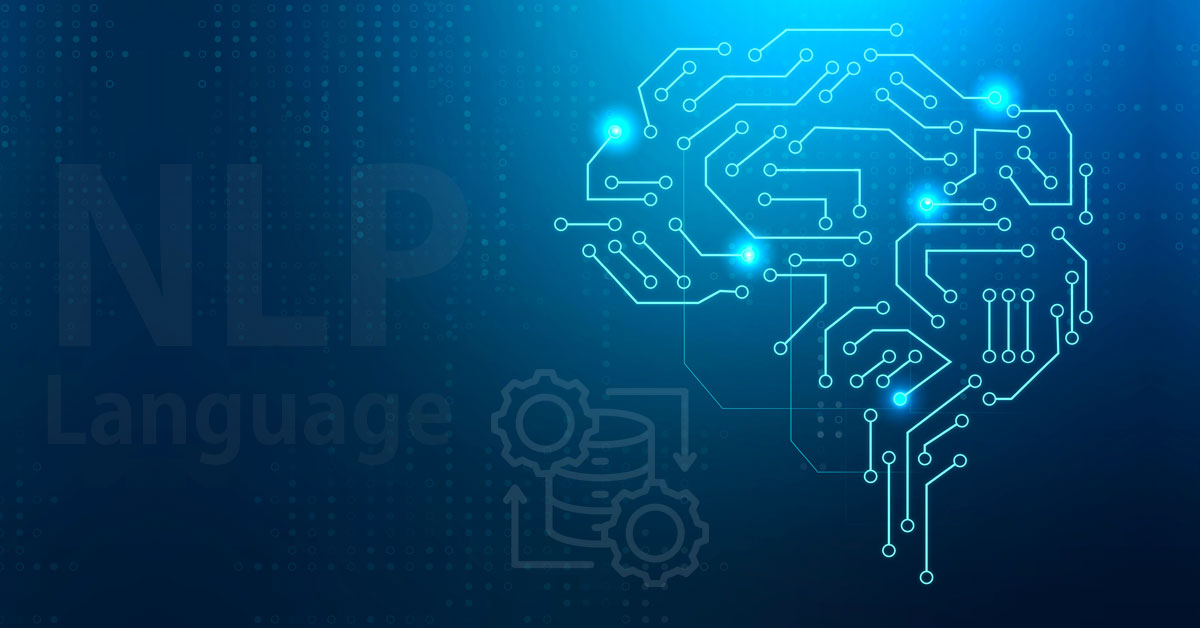NLP, Language and Data: The Trifecta of Modern Information Processing

8 min read
Modern information processing is centered on the intersection of language, data, and Natural Language Processing (NLP). This powerful trio dramatically transforms how we interact with, make sense of, and understand the massive amount of data that is all around us.
The technique known as natural language processing connects the binary world of machines with our linguistic world by enabling computers to understand and converse in human language. Language, the medium through which people express themselves, gives our words context, nuance, and richness. Both organized and unstructured data provide the starting point. From this starting point, new knowledge is generated, decisions are made, and insights are discovered.
We will discover how NLP, language, and data interact to power transformative applications as we explore this complex interplay, including sentiment analysis, language translation, and the perceptive virtual assistants that react to our spoken words. This trifecta opens up new possibilities in the rapidly changing field of contemporary communication and data consumption. It is more than simply a technological fusion; it is a paradigm shift in the way we process information.
NLP – A Revolution in Language Understanding
Explore the fascinating field of Natural Language Processing, an advanced area of artificial intelligence that aims to understand the nuances of human language.
What is NLP?
Natural Language Processing is known by its acronym, NLP. This area of study within artificial intelligence (AI) is centred on how computers and human language interact. With the use of natural language processing, machines should be able to understand, interpret, and produce meaningful human language. When it comes to activities like sentiment analysis, chatbot interactions, content summarization, language translation, and more. Processing language technology makes it feasible for computers to operate with text and speech data. Neural network processing is an essential part of contemporary information processing and communication technology, with applications ranging from text analysis tools to virtual assistants and search engines.
Applications
It is useful in many different fields. From improving customer service to supporting researchers as they analyze enormous datasets. Among the noteworthy uses are:
- Virtual chatbots and assistants: Well-known instances of natural processing language in operation are chatbots such as Google Assistant, Apple’s Siri, and also Amazon’s Alexa. They can understand written or spoken language, process user inquiries, and respond appropriately in a conversational style.
- Sentiment analysis: Analyze textual material to ascertain the sentiment or emotional tone that underlies it. In order to measure consumer happiness and modify their strategy accordingly, this is extremely helpful for firms that are keeping an eye on social media input from their customers.
- Language Translation: Google Translate and other similar services rely on NLP services. It can translate text mechanically between languages, removing barriers to communication between different cultures.
- Information Extraction: With so much data saved in the form of documents in industries like healthcare, banking, and law. So NLP data extraction can extract structured information from unstructured text.
- Content Generation: Chatbot answers, content generation, and other uses for coherent, contextually appropriate text can be produced by these models.
Challenges
NLP has come a long way, yet it still has problems that need to be acknowledged. It turns out that language is a difficult and constantly changing riddle. It encounters several challenges, including:
- Ambiguity: Depending on the context, words can have several meanings, and robots may find it difficult to discern the intended meaning.
- Context: Context is very important to language. Context comprehension is a difficult issue for AI language processing systems since the same words might have quite diverse meanings depending on the context or other words used.
- Cultural Nuances: Languages differ in their cultural idioms and nuances, which can make them difficult to translate or understand in other languages. NLP needs to be sensitive to cultural differences in order to provide reliable translations and interpretations.
- Bias and Fairness: Models for natural processing language can unintentionally reinforce biases found in training data. There is continuous work to improve the fairness and inclusivity of these systems.
The Power of Language
Language is more than simply words; it’s the means by which we communicate, express ourselves, and make sense of the world. Here, we will look at its complex relevance as we analyze its vital function in NLP data processing.
Read more: AI’s Natural Language Processing and Machine Learning Capabilities
Language as a Communication Tool
The foundation of human communication is language. It is the means by which we communicate our ideas, feelings, and thoughts to other people. Through language, we may communicate, build relationships, and spread culture. It has also evolved into the main means of information communication in the digital age. A testimonial to the power of language in contemporary communication may be seen in every tweet, text message, news item, and scientific paper.
Language is a common interface between humans and machines in the field of data processing. We communicate with computers, ask them questions, and get replies through language. So it serves as the link between the huge array of data-driven technology and human cognition. NLP is essential to this because it gives computers the ability to comprehend, interpret, and react to language, improving the accessibility and intuitiveness of human-computer interactions.
Semantic Understanding

Semantic comprehension is one of NLP’s main objectives. It seeks to understand the context and meaning of words in a phrase in addition to just identifying their terms. Understanding semantics is essential to realizing language’s full potential in data processing.
Think about the word “bark.” It could be referring to the bark of a dog or the bark of a tree, depending on the situation. To enable more precise data analysis and interpretation, natural language processing algorithms aim to ascertain the intended meaning within a given context. With the aid of semantic understanding, these systems can now comprehend information at a previously unthinkable level while doing tasks like sentiment analysis, content summarizing, and question-answering.
Language Evolution
The nature of language is dynamic; it is never static. It changes as a result of societal, cultural, and technological shifts and adapts accordingly. Language is still a live, breathing thing, constantly evolving with new terms, expressions, and idioms.
Language is changing at a rate never seen before in the digital age. Slang, emoji, and internet memes are just a few instances of how language changes to fit the online environment. It needs to adapt to these developments in order to continue on its mission to comprehend and analyze language. To stay relevant and effective in a world where language is always changing, it must acknowledge and adjust to the changing linguistic landscape.
Data – The Fuel for NLP
The complex relationship that exists between data and Natural Language Processing, explaining how data is essential to it and talking about how big data is changing the profession.
Data as the Foundation
Data is the foundation of natural language processing. Processing language is fundamentally a data-driven field of study. By examining enormous amounts of text and speech data, machines can acquire the ability to understand and interpret language. This data comes from a variety of sources, including books, articles, social media posts, and spoken conversation transcripts.
Databases, tables, and other organized information are examples of structured data that serve as a basis for NLP model training. However, the real problem for NLP systems is unstructured data. The vast bulk of linguistic data is unstructured and includes things like speech recordings and documents with free text. In order to interpret meaning and context, NLP algorithms must traverse this unstructured environment. Basically, an NLP system gets better at producing and understand human language the more data it has access to.
Big Data and NLP
NLP has undergone a revolution with the introduction of big data. The term “big data” describes the enormous amounts of data produced in the digital era, and it has had a significant influence on it. The proliferation of linguistic data on the internet and the corresponding rise in processing capacity has revolutionized the possibilities of language processing systems.
It can train its models on a wide range of sources by utilizing big data. It makes a wider range of languages, dialects, and writing styles understandable to language systems. It has also made it easier to build more context-aware virtual assistants and extremely precise machine translation systems.
However, there are drawbacks to this wealth of data. There are technological difficulties in processing and storing large databases. Furthermore, there is a higher chance that the data will be biased because it could represent preconceptions and biases in society that are present in the texts it is derived from. Researchers must consider the ethical ramifications of exploiting such data.
Data Quality and Ethics
NLP places a high priority on data quality. These models perform differently depending on how accurate and consistent the data used to train them is. Inaccurate or misinterpreted data can cause untrustworthy results. It takes preprocessing, cleaning, and validation procedures to maintain high standards in data quality, which is a continuous undertaking in NLP.
In addition, ethical issues are quite important. With increasing sophistication, natural language processing systems carry the risk of violating privacy, distorting data, or maintaining biases found in the training set. Privacy concerns bring up significant ethical issues, particularly when it comes to the analysis of personal data or private discussions. In the field, addressing these issues is a constant task.
The Trifecta in Action
We now go on to the practical uses of the data, language, and NLP synergy. Through an analysis of real-world scenarios and case studies, we will show how this trio is utilized to improve everyday situations and provide solutions to important issues.
-
Sentiment Analysis
One remarkable way NLP, language, and data intersect is through the practice of sentiment analysis. Sentiment analysis is the technique of determining if text data has a positive, negative, or neutral emotional tone and polarity. It is very important when it comes to decision-making, marketing, and customer feedback.
Social media has made it possible for people and businesses to gather enormous amounts of textual data. Sentiment analysis examines this data using processing language techniques to reveal public sentiment. Businesses can use sentiment analysis to assess client happiness, keep an eye on how their brand is perceived, and quickly respond to comments. For instance, an unfavourable spike in social media sentiment, can prompt a business to look into and resolve client complaints, thereby improving client relations. Additionally, sentiment analysis can assist in forecasting market trends, empowering companies to make data-driven choices.
-
Language Translation
People with varied linguistic origins may now communicate easily, through NLP’s revolutionary advancement in language translation. Through the use of these algorithms, services such as Google Translate facilitate cross-lingual communication by translating text across different languages.
NLP-driven translation systems use large multilingual datasets to understand the subtleties of various languages, idioms, and cultural contexts. They are able to recognize the original language automatically and instantly translate something understandable. These tools have broken through the barriers of traditional language hurdles, promoting global knowledge distribution, tourism, and international collaboration.
For example, NLP-powered language translation enables travellers to explore foreign nations with ease, students to access instructional information in multiple languages, and businesses to increase their reach into worldwide markets.
-
Personal Assistants
A new era of human-computer connection has been brought about by the rise of virtual personal assistants such as Alexa, Siri, and Google Assistant. These virtual assistants are invaluable in our daily lives because they use linguistic analysis to understand and reply to natural language inquiries.
These personal assistants can understand spoken language, handle inquiries, and provide pertinent answers in a conversational style. For example, with voice commands, they can respond to inquiries about general knowledge, give weather reports, create reminders, operate smart home appliances, and even start activities like sending messages or making appointments.
As a result, these personal assistants are trained on a large corpus of written and spoken language data, making them the perfect example of the trinity of NLP, language, and data. They are leading the charge in improving user experiences, automating processes, and enabling accessibility for people with different requirements.
Conclusion
It is impossible to overestimate the importance of language, NLP, and data in contemporary information processing. This trio has completely changed how we use technology, obtain information, and make decisions. It can change our world even more as it develops. So, it is a portal to comprehending and analyzing the abundance of linguistic data that surrounds us, not merely an analytical tool.
Responsible development and addressing ethical concerns are essential to realizing the full potential of natural language processing, NLP, and data. Although there are obstacles in this field, with perseverance and creativity, we can harness the incredible potential of this trifecta and create a future in which technology is able to understand humans on a more complex and meaningful level. Unquestionably, the continued developments in NLP will have a significant influence on how we engage with information and one another, influencing how we learn, communicate, and make decisions in a world where data is king.
Published: November 15th, 2023





